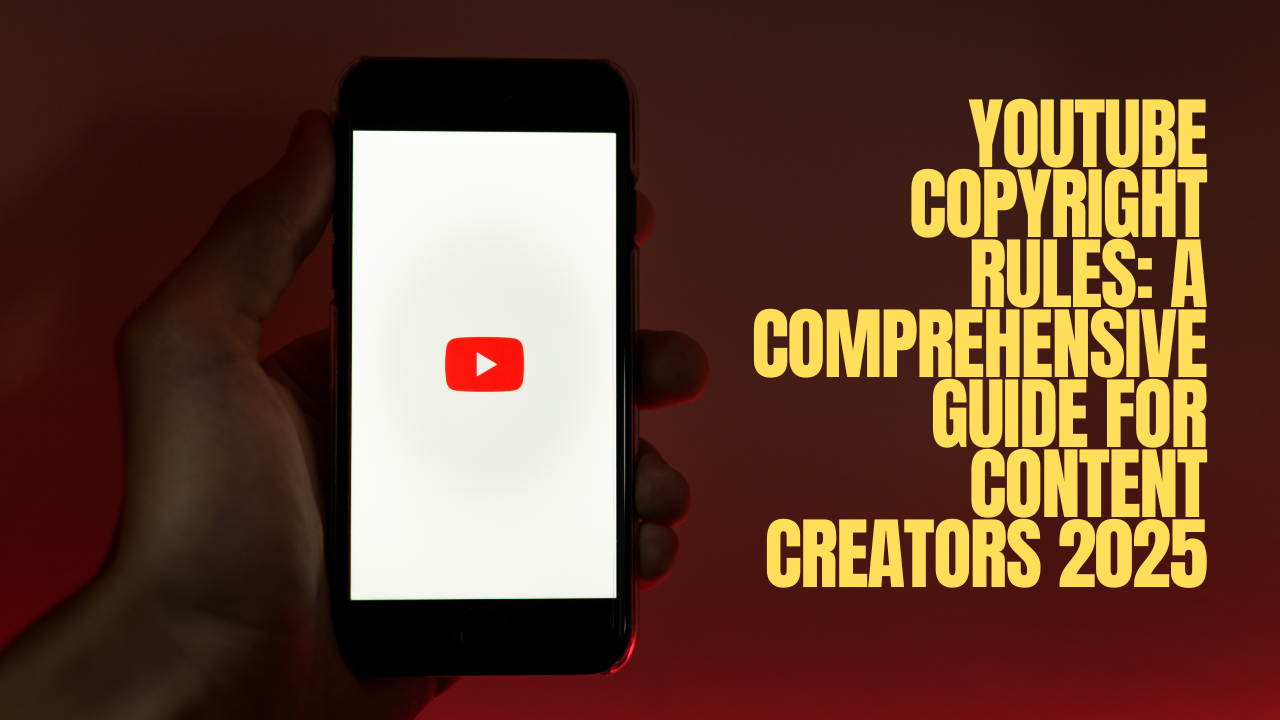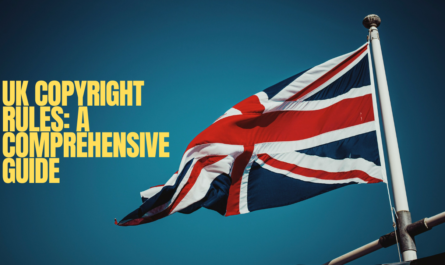Introduction
Youtube copyright rules YouTube has become one of the largest platforms for content creation, but with its immense reach comes stringent copyright regulations. Understanding YouTube’s copyright rules is essential for creators to avoid strikes, demonetization, and even legal action. This guide provides an in-depth look at YouTube’s copyright system, key rules, best practices, and how to protect your content while staying compliant.

Table of Contents
- Introduction
- What Is Copyright?
- Understanding YouTube’s Copyright System
- Best Practices for Avoiding Copyright Issues
- Case Studies: Notable Copyright Disputes on YouTube
- Recent Developments in YouTube Copyright Policies
- Summary and Key Takeaways
Also Read- UK Copyright Rules: A Comprehensive Guide 2025
What Is Copyright?
Copyright is a legal right granted to the creator of an original work, including videos, music, images, and written content. It provides the copyright owner with exclusive rights to use, distribute, and monetize their content. Unauthorized use of copyrighted material without permission can lead to copyright claims, strikes, and even lawsuits.
Relevant Copyright Laws
- U.S. Copyright Act (Title 17, U.S. Code) – Governs copyright in the United States and applies to content uploaded on YouTube.
- Digital Millennium Copyright Act (DMCA) – Provides a framework for online copyright protection and takedown notices.
- Berne Convention – An international agreement that protects works across multiple countries. YouTube Copyright Rules
Understanding YouTube Copyright Rules
YouTube enforces copyright through two main mechanisms:
1. Content ID System
YouTube’s automated Content ID system scans uploaded videos for copyrighted material. If a match is found, the copyright owner can:
- Monetize the video by placing ads on it.
- Track video performance without taking it down.
- Block the video from being viewed.
2. Copyright Strikes
A copyright strike occurs when a copyright owner manually issues a takedown request under the DMCA. Receiving three copyright strikes within 90 days results in:
- Termination of your YouTube channel.
- Removal of all uploaded videos.
- Loss of access to YouTube’s monetization features. YouTube Copyright Rules
3. Fair Use and Copyright Exceptions
Fair use is a legal doctrine that allows limited use of copyrighted material without permission under certain conditions:
- Purpose & Character – Transformative content, such as commentary, criticism, or parody, is more likely to be considered fair use.
- Nature of the Work – Using factual content (e.g., news) is more likely to be fair use than highly creative works (e.g., movies, songs).
- Amount & Substantiality – Using a small, non-central portion of a copyrighted work increases the likelihood of fair use.
- Effect on Market Value – If the use negatively impacts the copyright holder’s ability to profit, it is less likely to be considered fair use.
Best Practices for Avoiding Copyright Issues
1. Use Royalty-Free or Licensed Content
- Utilize platforms like Epidemic Sound, Artlist, or Storyblocks for music and stock footage.
- Check Creative Commons licenses to see if usage is permitted.
- Consider using public domain content that is free to use without restrictions.
2. Create Original Content

- Film your own footage.
- Use original graphics and music.
- Obtain permission for third-party content when necessary.
- Leverage AI-powered tools to generate royalty-free assets.
- Keep a record of permissions and licenses for reference.
3. Modify and Transform Content
- Add commentary, analysis, or education to existing material.
- Ensure the work is significantly different from the original.
- Edit and remix clips in a way that alters the original intent and adds new creative value.
- Apply effects, transitions, or overlays to transform the content visually.
4. Understand YouTube’s Copyright Claim Process
- If you receive a Content ID claim, review the claim details and either:
- Accept the claim.
- Dispute it if you believe it qualifies as fair use.
- If you receive a copyright strike, you can:
- Wait for it to expire (strikes expire after 90 days if no further action is taken).
- Submit a counter-notification if you believe the strike was wrongful.
- Seek permission from the copyright owner and request a retraction.
5. Use YouTube’s Copyright Tools
- YouTube Audio Library: Offers free music and sound effects.
- Copyright Match Tool: Helps creators find unauthorized reuploads of their content.
- YouTube Studio Dashboard: Provides real-time copyright claim notifications.
6. Understand YouTube’s Monetization Policies
- Ensure all music and visuals used in your videos are properly licensed.
- Be aware that some copyright owners allow monetization sharing, while others block monetization entirely.
- YouTube’s ad revenue split may be affected if a copyright claim is placed on your content.
Case Studies: Notable Copyright Disputes on YouTube

1. H3H3 Productions vs. Matt Hoss
In 2017, the YouTube channel H3H3 Productions was sued for copyright infringement after using clips from another creator’s video in a commentary piece. The court ruled in favor of H3H3, stating their use was transformative and fell under fair use.
2. Warner Bros. vs. YouTube Creators
Warner Bros. issued numerous copyright claims against YouTubers using short clips from its movies in reviews and critiques. Some claims were dismissed as fair use, while others led to channel demonetization.
3. YouTube vs. Music Copyright Holders
Music copyright holders frequently issue takedown requests for videos containing even a few seconds of copyrighted music. Some creators have successfully argued fair use, while others have faced permanent strikes.
4. Nintendo’s Content Policies
Nintendo has historically been strict with YouTubers using its game footage. Many content creators received copyright claims and lost monetization, leading Nintendo to introduce the Nintendo Creators Program, which later ended in favor of updated policies allowing some content use under fair conditions.
Also Read -Credit Cards For Poor Score -(2025)
Recent Developments in YouTube Copyright Policies
- YouTube’s 2023 Fair Use Clarifications: YouTube has improved its dispute resolution process for fair use claims.
- Music Partner Program Expansion (2024): Creators can now legally license mainstream songs with revenue-sharing options.
- Automatic Copyright Claim Reviews (2025): YouTube has implemented AI-based copyright claim reviews to reduce false positives.
- Stronger Penalties for Repeated Offenses: Channels with multiple copyright strikes now face increased scrutiny, including potential legal action.
- Updated Creator Copyright Transparency Reports: YouTube now provides detailed reports for creators about copyright claim sources and outcomes.
Summary and Key Takeaways
- YouTube enforces copyright through Content ID and copyright strikes.
- Fair use is a defense, but not a guaranteed protection.
- Using licensed or original content minimizes risk.
- Creators should understand YouTube’s dispute resolution options.
- Staying informed about policy updates is essential for compliance.
- Editing and transforming content can help strengthen fair use claims.
- Building relationships with copyright holders can lead to mutually beneficial licensing agreements.
By following these best practices and understanding YouTube’s copyright system, content creators can build a successful channel without fear of copyright violations. Always stay updated on new policies and legal precedents to ensure long-term success on the platform.
“We hope you like our article on YouTube Copyright Rules! Thanks for reading, and don’t forget to share your feedback in the comments. YouTube Copyright Rules are important to understand, and in this article, we cover YouTube Copyright Rules in detail. Stay informed about YouTube Copyright Rules to protect your content. Happy reading!”


One thought on “YouTube Copyright Rules: A Comprehensive Guide for Content Creators 2025”